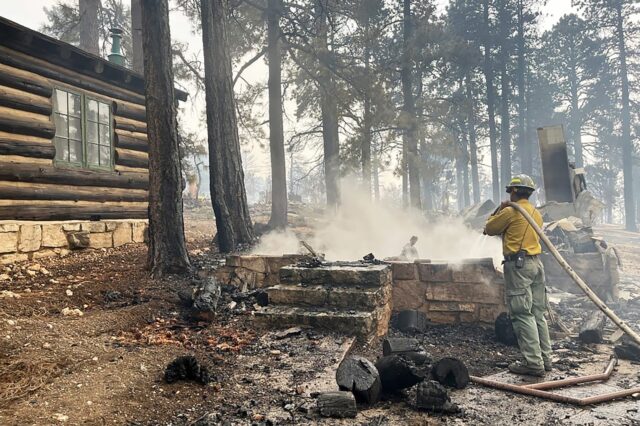Wildfire Destroys Historic Grand Canyon Lodge After Extended Delay in Response
A devastating wildfire has ravaged a historic lodge at the Grand Canyon, leading to questions regarding the National Park Service’s (NPS) handling of the situation. The blaze erupted from a lightning strike on July 4 and initially seemed manageable; however, it intensified over the weekend and has now destroyed over 70 structures, including the Grand Canyon Lodge itself, which served as the sole lodging on the North Rim.
Located in the seldom-visited North Rim area of the canyon, fire crews had initially opted for a “confine and contain” strategy, allowing the fire to burn for several days. This approach included monitoring the fire’s progress, as officials asserted that it posed no immediate threats to public safety or infrastructure. However, just days later, as conditions worsened with extreme heat and strong winds, officials issued urgent evacuation orders.
Fire Growth and Damages
By Friday, the fire had expanded nearly eightfold, covering 1.4 square miles (3.6 square kilometers). Its rapid spread evoked strong responses from state officials, prompting Arizona Governor Katie Hobbs to call for a federal investigation into the NPS’s management of the fire. She criticized the decision to allow the fire to burn during the region’s hottest and driest season, emphasizing the need for accountability.
Amidst the flames, the Grand Canyon Lodge was utterly consumed, along with employee accommodations and a wastewater treatment facility. Park Superintendent Ed Keable confirmed the situation prompted an immediate closure of North Rim access for the remainder of the year. The area typically attracts only about 10% of the millions who visit the Grand Canyon each year.
Evacuations and Safety Concerns
As the inferno surging through the North Rim threatened hikers and rafters, officials began evacuations. Visitors on the Colorado River were instructed to avoid Phantom Ranch, while trails from both the North and South rims were temporarily closed. Eyewitnesses from the South Rim reported alarming views of smoke billowing from the canyon.
Firefighters managed partial containment of the flames through aerial fire retardant drops. Nevertheless, they faced setbacks when a chlorine gas leak from the water treatment facility necessitated a strategic withdrawal to ensure safety.
Political Response and Future Implications
U.S. Senators Mark Kelly and Ruben Gallego addressed concerns to Interior Secretary Doug Burgum, questioning how wildfire management decisions will be documented following a new executive order aimed at consolidating federal firefighting efforts. The intensity of this wildfire is a stark reminder of the growing challenges faced by U.S. fire management strategies, especially in a year that has seen approximately 2.5 million acres (1 million hectares) consumed by wildfire across the Western United States.
Comparison of Two Major Fires:
| Fire Name | Area Burned (sq miles) | Status |
|---|---|---|
| Dragon Bravo Fire | 9 | Uncontained |
| White Sage Fire | 77 | In Progress |
The Legacy of Grand Canyon Lodge
The Grand Canyon Lodge, famed for its stunning views and majestic architecture, has been an iconic destination for visitors. This facility, adorned with rustic ponderosa beams and a limestone facade, captivated guests with its natural surroundings. Those who had the chance to stay at the lodge will carry cherished memories of the henceforth lost structure.
Among those grieving its loss is Caren Carney, who was visiting with her family when they received an urgent evacuation notice. “It was a magical place,” she expressed sorrowfully, recalling their last view of the lodge before it succumbed to the flames. The lodge’s history is marred by tragedy, as the original structure was destroyed by fire shortly after its construction in 1928, but it was later rebuilt and reopened in 1937.
The plight of the Grand Canyon area serves as a vivid illustration of the mounting pressures on both natural landscapes and emergency response protocols as wildfires continue to threaten iconic locations across the nation.














